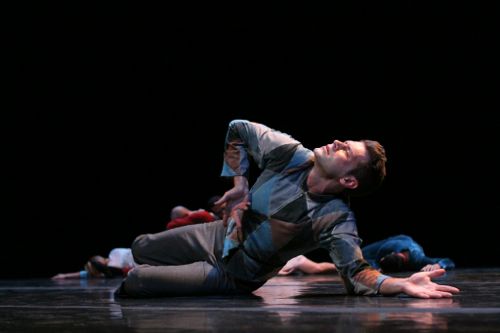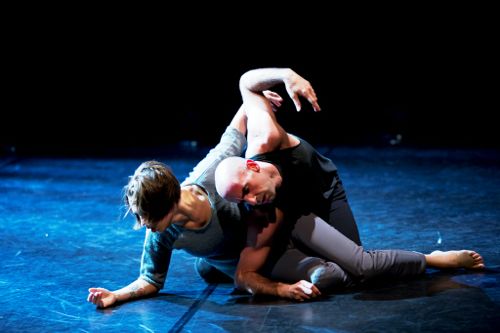Lar Lubovitch Dance Company / Florence Gould Hall, NYC / November 14-18, 2012
I hadn’t written about—or, for that matter, even seen—Lar Lubovitch’s choreography for a good many years. Attempting to remedy that, I trekked over to the East Side—in Manhattan, hardly the hotbed of dancing—to Florence Gould Hall, where his popular troupe was opening a five-day run. To my shame, I discovered that since I’d last seen his work, Lubovitch had been expanding his range way beyond the insistent fluid grace and communal rapport—“join hands and dance” stuff—that was always so lovely, and quickly so boring.
 Attila Joey Csiki in Lar Lubovitch’s new Transparent Things
Attila Joey Csiki in Lar Lubovitch’s new Transparent Things
Photo: Steven Schreiber
Transparent Things, aptly set to Debussy’s String Quartet in G Minor and being given its world premiere, was the most ambitious work on the program. The music was played onstage, vividly, by the Bryant Park Quartet: Anna Elashvili and Ben Russell (violins), Nathan Schram (viola), and Tomoko Fujita (cello). Lubovitch’s choreography is motivated by Picasso’s 1905 Family of Saltimbanques, which shows a half dozen impoverished street entertainers, two of them children, one an adolescent, one clearly the grandfatherly leader of the ragged troupe. The mood is all pathos and grace. Apart from the youngsters, the plight, the resignation, and the determination to persevere say much about the dancers of today, the majority of whom earn their keep through piecemeal work often having nothing to do with the art they refuse to abandon.
Picasso gives us melancholy grace expressed through pathos and the itinerant performers’ determination to follow their trade. Lubovitch doesn’t reflect that mood, though. His characters are considerably more feisty, except for the man in the Harlequin jacket (Attila Joey Csiki) who’s at the center of the piece. He’s the spiritual hero, if you will, of the group, in whom all of the others’ artistic yearnings are invested; I found that observation telling—in several ways.
Of course the choreography contains frequent use of a familiar Lubovitch motif: the players forming chains, separating for a moment, and then, with the insistence of magnets, relinking. But Lubovitch’s expanded vocabulary energizes the piece so that you feel, having watched it, that you’ve been somewhere instead of just surrendering with a sigh to the choreographer’s dream.
The six dancers were Clifton Brown, Csiki, Reed Luplau, Brian McGinnis, Laura Rutledge, and Katarzyna Sharpetowska. Reid Bartelme, formerly a Lubovitch dancer, created the costumes; the lighting was by Jack Mehler.
The program opened with Lubovitch’s 2007 Little Rhapsodies, a wry and charming title for a male trio that went nowhere, really, but was pleasant enough and occasionally witty. The guys (Csiki, Luplau, and McGinnis) acquitted themselves well to its Schumann score, with frisky feet (lots of ballet classes behind this, I imagine) and a general friendly playfulness tempered by passages suggesting sorrow, effort, aspiration, and disappointment. Its flaw, for me, was that it went on and on, without seeming to get anywhere. Even an abstract dance, or (as this is) one that’s semi-abstract, needs a climax and a resolution. True, there are exceptions to this rule, as Merce Cunningham proved again and again, but he had the privilege of genius.
 Katarzyna Skarpetowska and Brian McGinnis in Lubovitch’s Crisis Variations
Katarzyna Skarpetowska and Brian McGinnis in Lubovitch’s Crisis Variations
Photo: Paula Lobo
Back to back with Little Rhapsodies, came the dark, fraught Crisis Variations, created last year and set to music by Yevgeniy Sharlat that is based on Franz Liszt’s Transcendental Etudes and ideal for the occasion. Seeing it currently, in the wake of the Hurricane Sandy disaster, it seemed eerily of the moment. Yet when do we not face the end of the world?
Seven dancers mill around the stage space, a lonely crowd, so to speak, except for a duo presumably supported to some degree by the participants’ intimate relationship. But no, they’re all trying to jump out of their skin in their nameless suffering and horror. Lubovitch tracks them remorselessly if somewhat too pictorially. He’s especially adept at depicting a cluster of five, each person moving according to his individual script, yet part of a group statement. The overall impression is that of violent conflict, of the Nazis’ extermination of the Jews, indeed of the endless succession of wars humanity seems to birth. Lubovitch evokes humanity as a whole through presenting individuals who have reached the far end of experience, the only successor of which is death. Nevertheless, Kurt Jooss (in The Green Table) and Paul Taylor (in Last Look) have already covered the ground, fueled by a panoply of gifts with which Lubovitch can’t compete.
© 2012 Tobi Tobias



